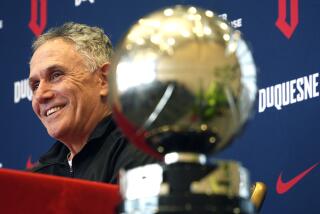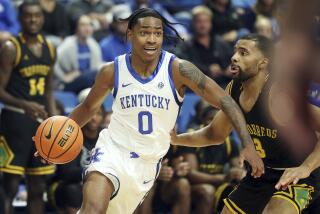On Trail of Blue-Chip Basketball Prospect With Duke Coaches
- Share via
DURHAM, N.C. — The Blue Chip Recruit, national bird of college basketball land, is a trophy of fortitude mounted above the mantels of only the keenest big-game hunters.
Take Danny Ferry at Duke University: From the time Ferry began playing for his high school varsity as a ninth grader until Ferry landed at Duke last fall, the pursuit went on. Four years of tracking, observing, examining. Four years of trying to speak the same language.
It turns out that Ferry fits Duke’s image of itself, and vice versa, both being academically aware yet determined to play basketball at its highest level. But nobody could be sure of that when the hunt started.
And every step of the way, Duke head Coach Mike Krzyzewski realized, there was that terrible danger of frightening the Blue Chipper away, of breaking off communications before they ever started.
“You don’t want to become a bother,” Krzyzewski said. “You don’t want to upset the apple cart.”
But, boy, you don’t want to let the prize get away, either. Krzyzewski has lost his share of top recruits: Bill Wennington, Chris Mullin and Uwe Blab all had considered Duke as one of their top two choices in 1980. Krzyzewski has gotten his share lately--Johnny Dawkins from D.C., Mark Alarie from Arizona and Jay Bilas from California have served as cornerstones of this season’s team. Still, landing that crop was no guarantee that he would get Ferry. Not since Gene Banks, in 1977, had Duke recruited a player everybody wanted. Everybody and his brother wanted Ferry.
He was a 6-10 hero playing at DeMatha in Hyattsville, Md., the UCLA of high schools. A name player from a name school, playing for a name coach, Morgan Wooten.
Krzyzewski and assistant Chuck Swenson, Duke’s recruiting coordinator, telephoned Wooten regularly for four years. Swenson, often with Krzyzewski in tow, flew routinely to Washington, for the drive to Hyattsville, to see Ferry play. They ate a lot of pizza and had a few beers with Wooten, as every recruiter of a DeMatha player does. They wrote to Ferry once a week, visited his home three times, had him visit Duke twice. There was one evening, Swenson remembered, when Krzyzewski badly miscalculated the travel time to a DeMatha road game in Cumberland, Md. “Mike told me it was only about an hour from D.C.,” Swenson said. “It was a good three hours through the mountains, driving 75 miles per hour.”
They made it. Swenson himself saw 30 of DeMatha’s 34 games last winter, “every game that did not conflict directly with our own schedule here,” he said.
In mid-February, following Duke’s afternoon game in New Jersey, Swenson flew immediately to Washington and drove to Silver Spring, Md., for a DeMatha night game. That gave Swenson just enough time to eat a hot dog, to see Ferry sprain his ankle in the first two minutes of play and to witness a power failure that put out the gym lights. “That is going above and beyond the call of duty,” Swenson said.
Even in the ACC. “Down here, see, recruiting is followed as religiously as the game is,” Krzyzewski said. “Maybe more so. It’s like a soap opera. ‘What will Lucy do with Jim tomorrow? Where will Danny go to college?’ ”
Sports call-in shows never ran out of opinions regarding Ferry’s future at Duke, North Carolina, Maryland or Virginia. In this state, everyone knew that Ferry had visited each of those schools, before narrowing his final choice to Duke and North Carolina--bitter rivals located only seven miles apart.
When Harvard played at Duke last February, a major spectator focus for the game was Danny Ferry’s older brother, Bob, the Harvard co-captain. Duke students chanted, “We want your brother! We want your brother!” throughout the warmups--only to have Bob Ferry mischievously startle them into silence by having teammate Kyle Dodson be his proxy for pregame introductions. Ferry is white; Dodson black.
“All of Harvard’s players looked at us and smiled,” Swenson said. And Duke smiled back. But there was just that split-second when all of Duke’s people worried that they had been chasing the wrong rainbow.
More than 50,000 miles were covered on Ferry’s trail, Swenson estimates. Some 60% of his recruiting energy and budget were spent on Ferry. And yet, there was an unusual amount of smooth traveling. Because of Ferry’s family, no time was wasted explaining basketball or higher education. Bob Sr. was a No. 1 draft pick of the NBA St. Louis Hawks in 1959, played 10 seasons in the league and, last year, was the NBA’s Executive of the Year in his 12th season as the Washington Bullets’ general manager. Bob Jr. was about to graduate from Harvard, on his way to a job as an investment banker for Kidder-Peabody.
Because of Ferry’s coach, no time was wasted on untangling recruiting procedures. Wooten had sent numerous players onto big-time college programs before, fellows such as Adrian Dantley, Kenny Carr, Adrian Branch, Sidney Lowe, Dereck Whittenburg.
“Who was going to do a snow job on Danny’s dad?” Krzyzewski asked. “Who was going to do a snow job on Morgan Wooten? They know what’s going on.”
Plus, Ferry had been a sound high school student, fully acceptable to Duke, which has among the highest academic requirements of Atlantic Coast Conference members. And Ferry seemed unusually level-headed from the beginning.
“It was exciting,” Ferry said, “as a high school freshman, to start getting recruited. But Coach Wooten put it in perspective for me pretty well, and, really, after that, where I would go to school was totally out of my mind until my senior year. I took my four visits and then, after that, I narrowed it to Duke and North Carolina.”
North Carolina. There is some evidence that the Blue Chip Recruit is the school bird of North Carolina, so great are their numbers on the Chapel Hill campus. “Carolina doesn’t recruit as much as it selects,” Swenson said. “Carolina picks the players it wants, and the players usually go.” Anytime Swenson would trek out of his way to see Ferry play and would find a North Carolina coach in the stands with him, he would worry. He would sweat. At one point, Swenson wrote on an index card:
“It’s the same. Danny won’t make a decision until April and is not worried about anything.”
Krzyzewski and Swenson talked, in short conversations with Ferry over several months, about playing style, about Ferry’s opportunity for playing time, about Ferry’s place in the future, about Duke’s other recruiting possibilities, about Duke’s way--no athletic dorms, no special academic breaks for jocks.
Before a basketball player can be offered a Duke scholarship, he must be accepted formally by the admissions office. “We’ve learned,” Swenson said, “not to spend time on the kids who don’t have the SATs. We’ve wasted time on kids like that before.” They have learned not to pursue recruits such as the fellow who told Swenson, “I don’t want to go to Duke. I don’t want to be a doctor.”
What Ferry wanted, not to be the star but to be allowed to play alongside stars, he has gotten so far. A preseason injury to Bilas let Ferry start immediately. He is averaging 25 minutes per game, leads the team in rebounding, is fifth in scoring. He is getting better, which is one thing he went to Duke to do.
And, as far as Ferry is concerned, the entire recruiting process was painless--no late-night calls, no hard-sell approaches. Toward the end, Ferry’s father had a few questions for him. One of them, “Where would you be happy your junior and senior years?”
Ferry telephoned the Duke basketball office on April 2 to say, “I’m coming to Duke and I’m really excited.” The Blue Chipper had landed.
More to Read
Go beyond the scoreboard
Get the latest on L.A.'s teams in the daily Sports Report newsletter.
You may occasionally receive promotional content from the Los Angeles Times.










